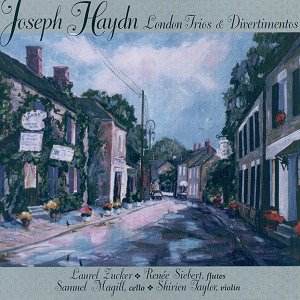The earliest music here is to be found
in the three divertimentos for flute,
violin and cello. These were published
by William Forster in London, in 1784.
There were actually six divertimentos,
and they all went through several later
editions, often with small changes.
It is a syncretic version that is used
here. These are pieces in which, somewhat
unusually for him, Haydn extensively
recycled earlier material; there are
many debts to his opera Il mondo
della luna, first performed a few
years earlier in 1777.
The so-called ‘London
Trios’ were, it seems, written ten years
later for some of Haydn’s London patrons,
Lord Abingdon and Sir Walter Aston,
both of whom were amateur flautists.
The flute had, for some time, been a
popular choice of instrument amongst
amateur musicians, and it was an instrument
for which Haydn had an evident fondness.
These very attractive trios were, however,
the last pieces of chamber music Haydn
was to write for the flute.
The two English aristocrats
were obviously very competent musicians,
for two flutes are given some quite
difficult material to negotiate. The
interplay between the two instruments
is often intricate, as in the counterpoint
in the first movement (marked ‘Spiritoso’)
of Hob. IV.3.
Laurel Zucker is a
fine musician whose playing is characterised
by intelligence, imagination and technical
certainty. I have heard with pleasure
a number of recordings by her – such
as those of Claude Bolling’s Jazz
Suites and the Handel Flute Sonatas.
I am not sure, however, that this particular
CD represents her at her best. Certainly
it is technically assured at all points
- some of the interweaving of lines
with Renée Siebert in the London
trios is very well handled, and Samuel
Magill is reliability itself. But it
all seems just a little cool, even a
little bland, and is not helped by a
recorded sound that isn’t of the very
best. There are quite a few places where
the music could bear a bit more characterisation.
These are by no means bad performances,
but they don’t make the most persuasive
of cases for the music. For that one
needs to look elsewhere – the London
Trios, for example have had very different
recordings by Camerata Köln (on
cpo) and by Rampal, Stern and Rostropovich
(on Sony).
Most of this is lightweight
Haydn, and these are pleasant, but unmemorable,
performances of it.
Glyn Pursglove


